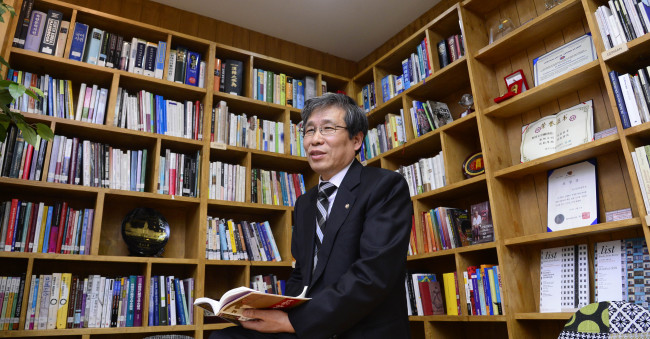‘Understanding of classic literature required to understand contemporary literature’
LTI Korea director Kim Seong-kon speaks about the institution’s current and future projects
By Claire LeePublished : Dec. 2, 2013 - 20:06

Last month, the Literature Translation Institute of Korea published a five-volume series of English translations of classic Korean literature in collaboration with The Korea Herald, an effort that took nearly one year to bear fruit.
“Whenever I went overseas, I met a lot of people who said they wanted to read more works of Korea’s classic literature,” Kim Seong-kon, the director of LTI Korea, said during an interview with The Korea Herald.
“And in order to understand contemporary literature (of any country), you have to understand the classic literature. These stories show how people interacted with one another, survived the wars, and fell in love in the Confucian society amid many social restrictions.”
The joint project, titled “Korean Classic Stories,” was one of the several efforts by LTI Korea this year to introduce Korean literature to foreign readers. November also saw the publication of a series of English-language translations of Korean literature for the first time in the U.S., and Kim said he’s up for more challenges.
Starting next year, he is to make more pitches to overseas publishers, including Random House, Harper & Row and Simon & Schuster, to publish English translations of Korean literature.
“Once published by these publishers, it becomes relatively easier to get reviews from the major media outlets (in the U.S.) and more likely for the books to receive attention,” Kim said.
And he will take a new approach with the pitches, Kim said. Up until this year, LTI Korea has been sending fully translated texts to foreign publishers instead of short summaries.
“We realized that takes too much time, energy and money,” he said. “So we decided to just translate highlights from each novel and provide a brief summary. We think it’ll be much more efficient and more appealing to overseas editors.”
Kim also wants to see Korea’s prominent authors have well-known translators who work exclusively with them and their works. Many celebrated Asian writers, including Haruki Murakami, Mo Yan and late Nobel laureate Yasunari Kawabata, each worked or are working with a single translator for English editions of their works, Kim said.
Kawabata, in particular, famously handed half of his prize money to his translator Edward Seidensticker when he became the first Japanese writer to receive the Nobel Prize for Literature in 1968.
“Most of Kawabata’s works were translated by Seidensticker,” said Kim. “For Haruki Murakami, there is Jay Rubin of Harvard University. For Mo Yan, there is Howard Goldblatt. We need more excellent translators (working exclusively) for Korean writers and their works.”
It’s been almost two years since Kim was appointed the director of LTI Korea, and 2013 is a busy year for him. He just returned from a trip to New York, where he was promoting the recently published series of Korean literature.
“It was a blast,” Kim told The Korea Herald about the promotional tour in New York. “There were about 30 scholars who teach Korean studies and Korean literature in universities in the U.S. and Canada. So it was pretty busy.”
The first 10 volumes of the 25-volume series, one of LTI Korea’s most anticipated projects this year, hit U.S. bookstores on Nov. 16. The 10 volumes include late Park Wan-suh’s collection of short stories “Lonesome You,” Jung Mi-kyung’s “My Son’s Girlfriend” and Jang Eun-jin’s “No One Writes Back.”
It is the first time such a project ― the series is a collaborative project with American publisher Dalkey Archive Press ― has taken place outside Korea. The remaining 15 volumes will be released next year.
Kim, who previously served as the director of Seoul National University Press, Seoul International Forum for Literature and the International Association of Korean Studies, has extensive experience teaching Korean literature overseas.
There were some hilarious and interesting moments, he recalled. For instance, an American student once told Kim that the two young protagonists of Hwang Sun-won’s 1959 short story “Rain Shower” ― an iconic, “innocent” tale of first love ― must have slept together and the girl must have gotten pregnant.
“I think it’s important to acknowledge the interpretations (of Korean literature) by both Koreans and those who study it overseas,” Kim said. “That way we can have a bigger discussion in a more inclusive way.”
The organization also recently announced that it would make its Korean Literature Translation Award, which used to be held biennially, an annual award starting this year.
Also for the first time, a Czech translation of Korean literature ― “Samguk Yusa,” a collection of folktales and historical legends written during and after the Three Kingdoms Period (A.D. 57-668) ― won the top prize at this year’s awards ceremony last month.
“The point is to have works of Korean literature translated into as many different languages as possible,” Kim said.
Kim said translation is a creative process that requires much more than just in-depth knowledge of the languages involved.
“Soviet poet and novelist Yevgeny Yevtushenko once said, ‘Translation is like a woman. If it is beautiful, it is not faithful. If it is faithful, it is most certainly not beautiful,” Kim said. “But really good translators would manage to be both, I think.”
By Claire Lee (dyc@heraldcorp.com)






![[KH Explains] How should Korea adjust its trade defenses against Chinese EVs?](http://res.heraldm.com/phpwas/restmb_idxmake.php?idx=644&simg=/content/image/2024/04/15/20240415050562_0.jpg&u=20240415144419)











![[Today’s K-pop] Stray Kids to return soon: report](http://res.heraldm.com/phpwas/restmb_idxmake.php?idx=642&simg=/content/image/2024/04/16/20240416050713_0.jpg&u=)